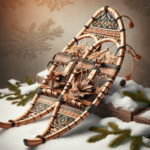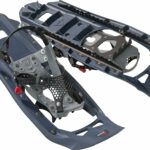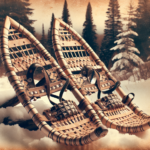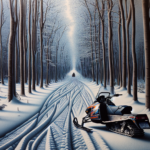Let’s embark on a journey deep into history, a period when survival revolved more around battling the elements rather than technology. The article “When Were Snowshoes Invented?” follows the fascinating trail of a simple, yet crucial invention that dates back thousands of years. This captivating narrative uncovers the mystery surrounding the creation of snowshoes, and how this primitive tool helped early humans traverse the treacherous snow-blanketed landscapes they called home. Your understanding of winter gear will transform as you learn not only about when snowshoes were first strapped on, but also the ingenious minds that made it possible. So, are you ready for this frosty expedition into the annals of human invention?
Origins of Snowshoes
When were snowshoes invented? Good question. Your ancestors needed to travel efficiently through snowy lands as early as 6,000 years ago. Snowshoes, a crucial piece of equipment facilitating movement in such harsh conditions, played a vital role in the survival and growth of civilizations worldwide.
Beginnings of Snowshoe Technology
The development of snowshoe technology involves some speculation based on archaeological and anthropological findings. In primitive times, materials available in the local surroundings were primarily utilized. Slabs of wood and bones were bound together, forming the first basic snowshoes. The aim was not to walk on top of the snow, but to spread a person’s weight over a larger surface to prevent them from sinking into the snow.
Notable Developments in Prehistoric Times
In prehistoric times, snowshoe design began to improve. Robust materials like caribou and other large animal hides were integrated into construction, while lashings were made from sinew or plant fibers. Deeper snow required more elongated and wider designs to provide greater flotation. The snowshoes became a signature tool of the Ice Age.
Snowshoes in Ancient Times
Snowshoe Designs in the Stone Age
In the Stone Age, people began to customize their snowshoes for different kinds of snow. Some were compact and wide for maneuverability in forested areas, while others were long and narrow for speed across the open tundra. A common design was oval, designed to mimic the foot shape of large, heavy animals that naturally distribute their weight while walking on snow.
Ancient Uses of Snowshoes
Snowshoes were essential survival tools in winter climates. Ancient people used them for routine activities, such as hunting, trapping, and migrations. Beyond facilitating travel, early snowshoes also played an essential role in warfare, enabling stealthy movements through snow-bound terrains.
Snowshoes in Various Cultures
Snowshoes in North American Culture
In North America, native tribes like the Inuits developed innovative and regionally-specific snowshoes with rawhide lacing and wooden frames. The Algonquin tribe, for instance, built bear paw snowshoes – circular and compact, perfect for wooded, snow-dense regions.
Snowshoes in Northern European Culture
In Northern Europe, the Sami people of Scandinavia developed a similar tool known as ‘skis’, which were significantly longer and narrower than traditional snowshoes. Influenced by their nomadic reindeer-herding lifestyle, they utilized these long and narrow skis for herding tasks and long-distance travel.
Snowshoes in Asian Culture
In Asia, particularly in Himalayan regions, snowshoes called ‘kamiks’ were made from wooden plates and animal hide to navigate through the heavy snow. They were crucial for the mountainous communities’ survival, helping them hunt, gather, and interact.
Crafting Traditional Snowshoes
Materials Used in Traditional Snowshoe Making
Traditional snowshoes were primarily crafted from wood, rawhide, sinew, and cordage. Wood like white ash was bent into shape, while rawhide strips were woven to create the supportive webbing. Sinew and cordage provided the necessary tension and durability to hold the foot in place.
Traditional Snowshoe Design and Construction
Designing traditional snowshoes involved bending a single piece of wood into a frame then attaching crossbars for stability. The rawhide or cordage was woven in intricate patterns across this frame, creating a web-like structure to spread the wearer’s weight over a wide surface area. The snowshoes were then sealed with a mixture of resin and pine pitch to ensure water-resistance.
Evolution of Snowshoes through History
Middle Ages to Early Modern Period
From Middle Ages to the early modern period, snowshoes remain fairly consistent in design with regional variations. They were invaluable during military campaigns during the winter. The French and British forces in North America, for instance, employed native allies and their knowledge of snowshoeing during conflicts.
Industrial Revolution and Snowshoe Design
The industrial revolution brought new materials into the scene – metal and synthetic materials replaced traditional wooden frames and rawhide lacing. These changes led to more durable, lightweight, and maintenance-free designs.
Modern Snowshoes
Introduction of Metal and Synthetic Materials
ASM (Aluminum Snowshoe Manufacturing) in the 1970s introduced the first aluminum and neoprene snowshoes. This was a revolutionary change. Modern materials combined with traditional designs led to hard-rubber foot-pads, adjustable bindings, and stainless-steel crampons for gripping icy surfaces.
Contemporary Snowshoe Design and Functionality
Today, snowshoes are designed with modern materials and employ innovative mechanisms. They feature design improvements like rotating bindings, allowing for more natural strides, and improved grip systems. Advancements have resulted in shoes that are lighter, stronger, and more comfortable.
Impact of Snowshoes on Exploration and Travel
Snowshoes in Arctic and Antarctic Exploration
Snowshoes proved crucial for explorations in the Polar Regions. They provided explorers with the capability of traversing vast icy landscapes. From Norwegian Roald Amundsen reaching the South Pole to Admiral Robert Peary venturing in the North Pole, snowshoes were instrumental in their endeavors.
Snowshoes in Mountaineering and Wilderness Travel
In wilderness travel and mountaineering, snowshoes allow adventurers to explore high-altitude, snowy environments. Whether it’s traversing alpine trails or setting new routes on unexplored ridgelines, snowshoes have become an essential gear item.
Snowshoeing as a Sport
Rise of Recreational Snowshoeing
As access to snowbound, wilderness areas increased, so did recreational snowshoeing. It grew as a hobby among outdoor enthusiasts interested in winter activities. Today, snowshoeing is a popular form of winter exercise, providing a fun and low-impact workout while enjoying the snowy landscapes.
Snowshoe Racing and Competitions
Snowshoe racing took center stage in the late 19th century, and today, there are national and international snowshoe racing competitions. They test an athlete’s stamina, agility, and endurance, inviting participants of all ages and skill levels.
Technological Innovations in Snowshoe Design
Developments in Snowshoe Binding Systems
Today’s snowshoe binding systems feature quick-release buckles and heel straps for easy adjustments. Some even boast a pivot-style setup, allowing the foot to hinge freely and making walking in snowshoes as natural as walking in your favorite pair of boots.
Advancements in Traction and Flotation
Snowshoes are now better tailored for specific activities or environments. Climbing-style crampons provide improved traction on rugged terrains, while flexible, lightweight materials provide better flotation.
Future of Snowshoes
Anticipated Trends in Snowshoe Design
The future of snowshoes may be molded by advancements in material science. Lighter and tougher materials, enhanced grip mechanisms, and easy-to-adjust bindings are anticipated trends in snowshoe design. There’s exciting potential for them to become more efficient and comfortable, allowing for more extended expeditions across snowy landscapes.
Potential Uses and Benefits of Snowshoes in the Future
Beyond sport and recreation, the future uses of snowshoes may expand. They can be crucial during winter emergencies or search and rescue operations in snow-bound areas. Eco-tourism could also leverage snowshoes, showcasing the beauty of winter landscapes while promoting a low-impact, eco-friendly way to travel through them. In essence, the future holds exciting potential for this millennia-old invention. Whoever said “everything old is new again” must’ve been thinking about our fascination with snowshoes.
- What Snowboard Bindings Should I Get? - January 23, 2024
- What Size Screws For Snowboard Bindings? - January 23, 2024
- How To Snowmobile On Water? - January 23, 2024










